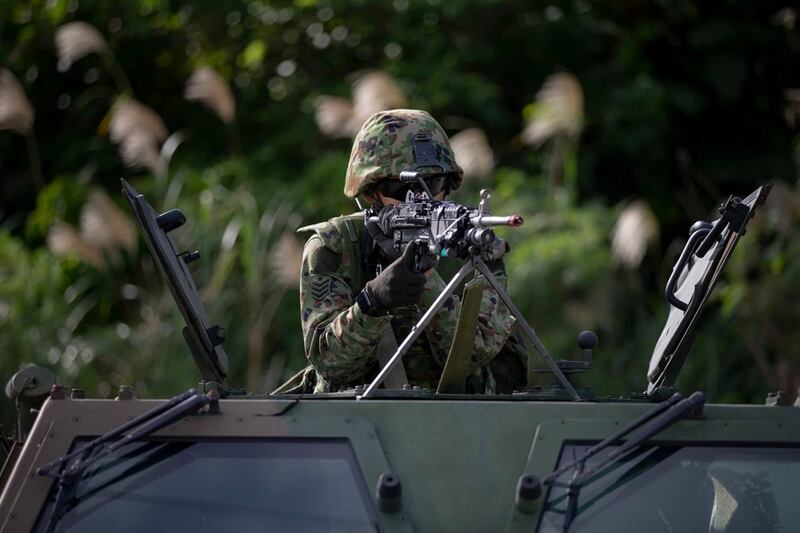The Japanese and U.S. militaries will hold another large-scale joint exercise next month, this time also joined by ships and aircraft from Australia, Canada and the United Kingdom.
Exercise 'Keen Sword' will take place from Nov. 10-19 on military installations in Japan, its surrounding waters and airspace. The theme this year will be joint responses in gray zone situations and to armed attacks, the Japanese Defense Ministry's Joint Staff Office said in a statement.
The exercise involving 26,000 troops, 20 ships and 250 aircraft from Japan; plus 10,000 troops, 10 ships and 120 aircraft from the U.S. side “will test the readiness and improve the interoperability” between the two militaries, the statement said.
The soldiers, ships and aircraft are drawn from different branches of Japan’s self-defense forces including the army, navy, air force and the marines, as well as the space force.
Alongside the Japanese and American troops, personnel from four warships and two aircraft from Australia, Canada and the U.K. will also take part.
The joint exercise will demonstrate “our strong will to never allow any attempt to change the status quo” in the region, the Japanese statement said.
‘Keen Sword’ was first held in 1985, with field training and command post exercises, also known as ‘Keen Edge’, alternating every year. This year’s event is the 16th field training exercise.

Security threats from China
The joint drills will take place on and around Amami Oshima and Tokonushima islands in southern Japan, as well as on Tsutara Island, west of Nagasaki.
The drills will include an array of joint operations such as amphibious, land, naval and air operations. The two sides will also conduct a combined logistics supply operation and a special operation in the space and cyber fields.
Japan and the U.S. have just completed a three-day joint training exercise, Resolute Dragon, in the Aomori Prefecture, Japan, on Oct. 13.
Before that, maritime forces from Japan, Canada and the U.S. conducted joint exercise Noble Raven in the South China Sea from Sept. 23 to Oct.1, in which Japan deployed one of its submarines.
As China becomes increasingly assertive in the South China Sea and the East China Sea, Japan and allies in the region seek to hold more regular joint military exercises and deepen cooperation.

On Saturday, Japanese Prime Minister Fumio Kishida and his Australian counterpart Anthony Albanese signed a security agreement to strengthen security ties between the two countries.
Tokyo and Canberra pledged to accelerate their exchange of intelligence and Japan’s military will train and exercise alongside Australian troops in northern Australia, according to the newly-signed Joint Declaration on Security Cooperation.
“We need to work together to build common defense capabilities so that Australian and Japanese military forces can work together more easily, such as with the U.S. under “integrated deterrence,” which is a centrepiece of the U.S. National Security Strategy,” said Malcolm Davis, a senior analyst in defense strategy and capability at the Australian Strategic Policy Institute.
‘Asian NATO’
The agreement, although it doesn’t mention China, is largely seen as an effort to counter growing security threats from Beijing.
Australia and Japan, together with the U.S. and India, are already part of the Quadrilateral Security Dialogue, commonly known as the Quad.
The two countries “need to strengthen the Quad's ability to deal with hard security and defense issues,” according to Davis.
The analyst said Australia should also look at how Japan could play a role in AUKUS, another security-focused grouping between Australia, the U.K. and the U.S.
China has repeatedly criticized what Beijing calls attempts by the U.S. and partners to form ‘an Asian NATO.”
Chinese Foreign Ministry spokesperson Wang Wenbin said on Monday the region "does not need military blocs, still less groupings that could provoke bloc confrontation or stoke a new Cold War."
Speaking of the Australia-Japan new security pact, Wang said that bilateral cooperation needs to be conducive to mutual understanding and trust among countries, “rather than target any third party or undermine their interests.”
“Beijing wants to sabotage Australia's defense and strategic relationships, and break up U.S. alliance structures across the Indo-Pacific,” said Canberra-based Davis.
“So, we're going to ignore Chinese outbursts and move forward to strengthen defense relations between Canberra and Tokyo, as that's in our national interest,” he said.
